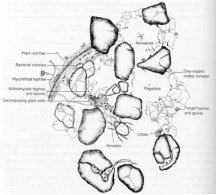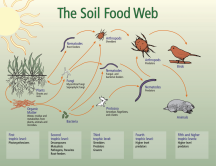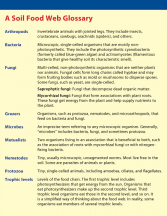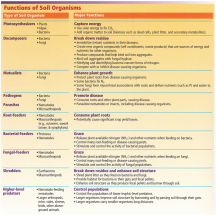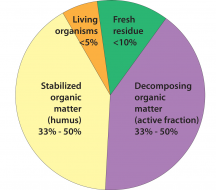SOIL BIOLOGY AND THE LANDSCAPE
An incredible diversity of organisms make up the soil food web. They range in size from the tiniest one-celled bacteria, algae, fungi, and protozoa, to the more complex nematodes and micro-arthropods, to the visible earthworms, insects, small vertebrates, and plants.
As these organisms eat, grow, and move through the soil, they make it possible to have clean water, clean air, healthy plants, and moderated water flow.
There are many ways that the soil food web is an integral part of landscape processes. Soil organisms decompose organic compounds, including manure, plant residue, and pesticides, preventing them from entering water and becoming pollutants. They sequester nitrogen and other nutrients that might otherwise enter groundwater, and they fix nitrogen from the atmosphere, making it available to plants. Many organisms enhance soil aggregation and porosity, thus increasing infiltration and reducing runoff. Soil organisms prey on crop pests and are food for above-ground animals.
The soil environment. Organisms live in the microscale environments within and between soil particles. Differences over short distances in pH, moisture, pore size, and the types of food available create a broad range of habitats.
The Food Web: Organisms and Their Interaction
The soil food web is the community of organisms living all or part of their lives in the soil. A food web diagram shows a series of conversions (represented by arrows) of energy and nutrients as one organism eats another.
All food webs are fueled by the primary producers: the plants, lichens, moss, photosynthetic bacteria, and algae that use the sun's energy to fix carbon dioxide from the atmosphere. Most other soil organisms get energy and carbon by consuming the organic compounds found in plants, other organisms, and waste by-products. A few bacteria, called chemoautotrophs, get energy from nitrogen, sulfur, or iron compounds rather than carbon compounds or the sun.
As organisms decompose complex materials, or consume other organisms, nutrients are converted from one form to another, and are made available to plants and to other soil organisms. All plants - grass, trees, shrubs, agricultural crops - depend on the food web for their nutrition.
What Do Soil Organisms Do?
Growing and reproducing are the primary activities of all living organisms. As individual plants and soil organisms work to survive, they depend on interactions with each other. By-products from growing roots and plant residue feed soil organisms. In turn, soil organisms support plant health as they decompose organic matter, cycle nutrients, enhance soil structure, and control the populations of soil organisms including crop pests.
Organic Matter Fuels the Food Web
Organic matter is many different kinds of compounds - some more useful to organisms than others. In general, soil organic matter is made of roughly equal parts humus and active organic matter. Active organic matter is the portion available to soil organisms. Bacteria tend to use simpler organic compounds, such as root exudates or fresh plant residue. Fungi tend to use more complex compounds, such as fibrous plant residues, wood and soil humus.
Intensive tillage triggers spurts of activity among bacteria and other organisms that consume organic matter (convert it to CO2), depleting the active fraction first. Practices that build soil organic matter (reduced tillage and regular additions of organic material) will raise the proportion of active organic matter long before increases in total organic matter can be measured. As soil organic matter levels rise, soil organisms play a role in its conversion to humus - a relatively stable form of carbon sequestered in soils for decades or even centuries.
Soil organic matter is the storehouse for the energy and nutrients used by plants and other organisms. Bacteria, fungi, and other soil dwellers transform and release nutrients from organic matter. These microshredders, immature oribatid mites, skeletonize plant leaves. This starts the nutrient cycling of carbon, nitrogen, and other elements.
An incredible diversity of organisms make up the soil food web. They range in size from the tiniest one-celled bacteria, algae, fungi, and protozoa, to the more complex nematodes and micro-arthropods, to the visible earthworms, insects, small vertebrates, and plants.
As these organisms eat, grow, and move through the soil, they make it possible to have clean water, clean air, healthy plants, and moderated water flow.
There are many ways that the soil food web is an integral part of landscape processes. Soil organisms decompose organic compounds, including manure, plant residue, and pesticides, preventing them from entering water and becoming pollutants. They sequester nitrogen and other nutrients that might otherwise enter groundwater, and they fix nitrogen from the atmosphere, making it available to plants. Many organisms enhance soil aggregation and porosity, thus increasing infiltration and reducing runoff. Soil organisms prey on crop pests and are food for above-ground animals.
The soil environment. Organisms live in the microscale environments within and between soil particles. Differences over short distances in pH, moisture, pore size, and the types of food available create a broad range of habitats.
The Food Web: Organisms and Their Interaction
The soil food web is the community of organisms living all or part of their lives in the soil. A food web diagram shows a series of conversions (represented by arrows) of energy and nutrients as one organism eats another.
All food webs are fueled by the primary producers: the plants, lichens, moss, photosynthetic bacteria, and algae that use the sun's energy to fix carbon dioxide from the atmosphere. Most other soil organisms get energy and carbon by consuming the organic compounds found in plants, other organisms, and waste by-products. A few bacteria, called chemoautotrophs, get energy from nitrogen, sulfur, or iron compounds rather than carbon compounds or the sun.
As organisms decompose complex materials, or consume other organisms, nutrients are converted from one form to another, and are made available to plants and to other soil organisms. All plants - grass, trees, shrubs, agricultural crops - depend on the food web for their nutrition.
What Do Soil Organisms Do?
Growing and reproducing are the primary activities of all living organisms. As individual plants and soil organisms work to survive, they depend on interactions with each other. By-products from growing roots and plant residue feed soil organisms. In turn, soil organisms support plant health as they decompose organic matter, cycle nutrients, enhance soil structure, and control the populations of soil organisms including crop pests.
Organic Matter Fuels the Food Web
Organic matter is many different kinds of compounds - some more useful to organisms than others. In general, soil organic matter is made of roughly equal parts humus and active organic matter. Active organic matter is the portion available to soil organisms. Bacteria tend to use simpler organic compounds, such as root exudates or fresh plant residue. Fungi tend to use more complex compounds, such as fibrous plant residues, wood and soil humus.
Intensive tillage triggers spurts of activity among bacteria and other organisms that consume organic matter (convert it to CO2), depleting the active fraction first. Practices that build soil organic matter (reduced tillage and regular additions of organic material) will raise the proportion of active organic matter long before increases in total organic matter can be measured. As soil organic matter levels rise, soil organisms play a role in its conversion to humus - a relatively stable form of carbon sequestered in soils for decades or even centuries.
Soil organic matter is the storehouse for the energy and nutrients used by plants and other organisms. Bacteria, fungi, and other soil dwellers transform and release nutrients from organic matter. These microshredders, immature oribatid mites, skeletonize plant leaves. This starts the nutrient cycling of carbon, nitrogen, and other elements.
Last edited:

